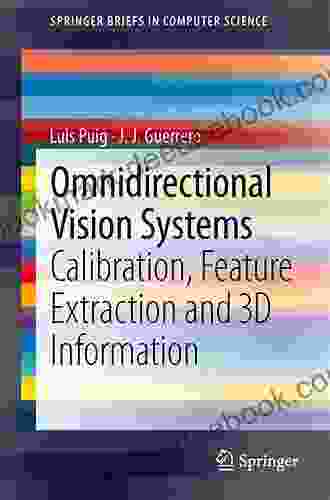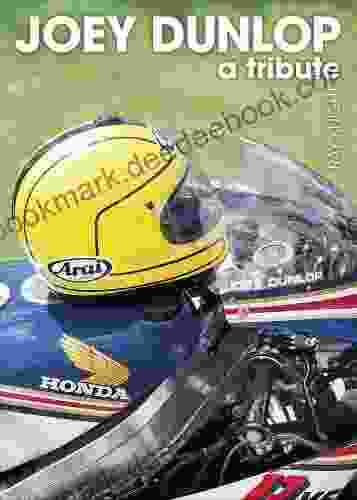Calibration Feature Extraction and 3D Information: SpringerBriefs in Computer Science

Camera calibration is the process of determining the intrinsic and extrinsic parameters of a camera. The intrinsic parameters include the focal length, the principal point, and the distortion coefficients. The extrinsic parameters include the rotation and translation vectors between the camera and the world coordinate frame.
Feature extraction is the process of identifying and extracting key features from an image. These features can be used for a variety of purposes, such as object recognition, tracking, and matching.
3D information extraction is the process of reconstructing a 3D model of a scene from a set of 2D images. This can be done using a variety of techniques, such as stereo vision, structure from motion, and depth from focus.
4.5 out of 5
| Language | : | English |
| File size | : | 9133 KB |
| Text-to-Speech | : | Enabled |
| Screen Reader | : | Supported |
| Enhanced typesetting | : | Enabled |
| Print length | : | 202 pages |
| Hardcover | : | 524 pages |
| Item Weight | : | 7.8 ounces |
| Dimensions | : | 8 x 0.25 x 8 inches |
| Library Binding | : | 24 pages |
| Reading age | : | 4 - 7 years |
| Lexile measure | : | BR |
| Grade level | : | Preschool - 2 |
This book provides a comprehensive overview of the key concepts and techniques used in camera calibration, feature extraction, and 3D information extraction. It is intended for students, researchers, and practitioners who are interested in these areas.
Camera calibration is the process of determining the intrinsic and extrinsic parameters of a camera. The intrinsic parameters include the focal length, the principal point, and the distortion coefficients. The extrinsic parameters include the rotation and translation vectors between the camera and the world coordinate frame.
There are a number of different methods for camera calibration. One common method is to use a calibration pattern, which is a known 3D object with a known pattern of points. The camera is then used to take images of the calibration pattern from a variety of different angles. The images are then processed to extract the 3D coordinates of the points on the calibration pattern. These coordinates can then be used to determine the intrinsic and extrinsic parameters of the camera.
Another method for camera calibration is to use a set of known 3D points. The camera is then used to take images of these points from a variety of different angles. The images are then processed to extract the 2D coordinates of the points in the images. These coordinates can then be used to determine the intrinsic and extrinsic parameters of the camera.
Feature extraction is the process of identifying and extracting key features from an image. These features can be used for a variety of purposes, such as object recognition, tracking, and matching.
There are a number of different feature extraction algorithms available. Some of the most common algorithms include:
- SIFT (Scale-Invariant Feature Transform): SIFT is a feature extraction algorithm that is invariant to scale and rotation. It is one of the most widely used feature extraction algorithms for object recognition.
- SURF (Speeded Up Robust Features): SURF is a feature extraction algorithm that is similar to SIFT, but it is faster and more robust to noise.
- ORB (Oriented FAST and Rotated BRIEF): ORB is a feature extraction algorithm that is based on the FAST corner detector and the BRIEF descriptor. It is very fast and efficient, but it is not as accurate as SIFT or SURF.
- KAZE (Features from Accelerated Segment Test): KAZE is a feature extraction algorithm that is based on the FAST corner detector and the MSER descriptor. It is very fast and efficient, and it is also more accurate than ORB.
3D information extraction is the process of reconstructing a 3D model of a scene from a set of 2D images. This can be done using a variety of techniques, such as stereo vision, structure from motion, and depth from focus.
Stereo vision is a technique for 3D information extraction that uses two cameras to take images of a scene. The images are then processed to extract the disparity between the corresponding points in the images. The disparity can then be used to compute the depth of the points in the scene.
Structure from motion is a technique for 3D information extraction that uses a set of images of a scene that are taken from different viewpoints. The images are then processed to extract the 3D motion of the camera. The 3D motion can then be used to compute the depth of the points in the scene.
Depth from focus is a technique for 3D information extraction that uses a single camera to take images of a scene at different focus settings. The images are then processed to extract the depth of the points in the scene.
Camera calibration, feature extraction, and 3D information extraction have a wide range of applications in computer vision and robotics. These applications include:
- Object recognition: Camera calibration and feature extraction can be used to recognize objects in images. This is useful for a variety of applications, such as object tracking, object counting, and object classification.
- Tracking: Camera calibration and feature extraction can be used to track objects in videos. This is useful for a variety of applications, such as motion analysis, surveillance, and robotics.
- Matching: Camera calibration and feature extraction can be used to match images of the same scene taken from different viewpoints. This is useful for a variety of applications, such as photo stitching, panorama creation, and 3D reconstruction.
- 3D reconstruction: Camera calibration, feature extraction, and 3D information extraction can be used to reconstruct 3D models of scenes from 2D images. This is useful for a variety of applications, such as virtual reality, augmented reality, and medical imaging.
Camera calibration, feature extraction, and 3D information extraction are important techniques in computer vision and robotics. These techniques have a wide range of applications, including object recognition, tracking, matching, and 3D reconstruction.
This book has provided a comprehensive overview of the key concepts and techniques used in camera calibration, feature extraction, and 3D information extraction. It is intended for students, researchers, and practitioners who are interested in these areas.
4.5 out of 5
| Language | : | English |
| File size | : | 9133 KB |
| Text-to-Speech | : | Enabled |
| Screen Reader | : | Supported |
| Enhanced typesetting | : | Enabled |
| Print length | : | 202 pages |
| Hardcover | : | 524 pages |
| Item Weight | : | 7.8 ounces |
| Dimensions | : | 8 x 0.25 x 8 inches |
| Library Binding | : | 24 pages |
| Reading age | : | 4 - 7 years |
| Lexile measure | : | BR |
| Grade level | : | Preschool - 2 |
Do you want to contribute by writing guest posts on this blog?
Please contact us and send us a resume of previous articles that you have written.
 Novel
Novel Page
Page Story
Story Genre
Genre Reader
Reader E-book
E-book Magazine
Magazine Sentence
Sentence Shelf
Shelf Glossary
Glossary Foreword
Foreword Preface
Preface Synopsis
Synopsis Footnote
Footnote Manuscript
Manuscript Scroll
Scroll Tome
Tome Bestseller
Bestseller Classics
Classics Narrative
Narrative Autobiography
Autobiography Encyclopedia
Encyclopedia Character
Character Resolution
Resolution Card Catalog
Card Catalog Stacks
Stacks Periodicals
Periodicals Study
Study Research
Research Scholarly
Scholarly Academic
Academic Rare Books
Rare Books Special Collections
Special Collections Study Group
Study Group Storytelling
Storytelling Awards
Awards Reading List
Reading List Book Club
Book Club Theory
Theory Textbooks
Textbooks Silvia Federici
Silvia Federici Douglas Hirt
Douglas Hirt Steven N Kelly
Steven N Kelly Paul Oswell
Paul Oswell Connell Barrett
Connell Barrett Anthony Metivier
Anthony Metivier Bouko De Groot
Bouko De Groot Kim De Blecourt
Kim De Blecourt Debra Denker
Debra Denker Joe Jack Wallace
Joe Jack Wallace Meredith Jones
Meredith Jones John Cambridge
John Cambridge Rajesh K Tyagi
Rajesh K Tyagi Julie Herman
Julie Herman Chekitan S Dev
Chekitan S Dev Suzanne Goldring
Suzanne Goldring Brooke Levine
Brooke Levine Chinua Achebe
Chinua Achebe Liz Ball
Liz Ball Chris Coelho
Chris Coelho
Light bulbAdvertise smarter! Our strategic ad space ensures maximum exposure. Reserve your spot today!
 Amir SimmonsFollow ·15.2k
Amir SimmonsFollow ·15.2k Michael CrichtonFollow ·10.7k
Michael CrichtonFollow ·10.7k Stanley BellFollow ·8.6k
Stanley BellFollow ·8.6k J.R.R. TolkienFollow ·8k
J.R.R. TolkienFollow ·8k Bobby HowardFollow ·16k
Bobby HowardFollow ·16k Jeremy MitchellFollow ·11.4k
Jeremy MitchellFollow ·11.4k Troy SimmonsFollow ·2.6k
Troy SimmonsFollow ·2.6k Blake BellFollow ·5.1k
Blake BellFollow ·5.1k

 Oscar Wilde
Oscar WildeDon't Stop Thinking About the Music: Exploring the Power...
Music is an...

 Floyd Richardson
Floyd RichardsonSnowman Story Problems Math With Santa And Friends
It's a cold winter day, and...

 W. Somerset Maugham
W. Somerset MaughamWhat Every Classroom Teacher Needs To Know: A...
Teaching is a challenging...

 Edgar Cox
Edgar CoxTall Tales But True: A Lifetime of Motorcycling...
I've been riding motorcycles for over 50...

 Chinua Achebe
Chinua AchebeBuni: Happiness Is a State of Mind
Buni is a beautiful...

 Herman Melville
Herman MelvilleThe Arts and Crafts of Older Spain: Embodying the Essence...
In the heart of the Iberian...
4.5 out of 5
| Language | : | English |
| File size | : | 9133 KB |
| Text-to-Speech | : | Enabled |
| Screen Reader | : | Supported |
| Enhanced typesetting | : | Enabled |
| Print length | : | 202 pages |
| Hardcover | : | 524 pages |
| Item Weight | : | 7.8 ounces |
| Dimensions | : | 8 x 0.25 x 8 inches |
| Library Binding | : | 24 pages |
| Reading age | : | 4 - 7 years |
| Lexile measure | : | BR |
| Grade level | : | Preschool - 2 |












